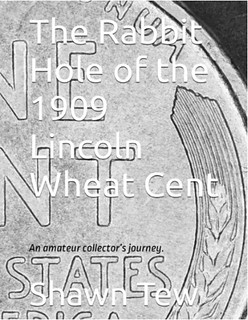
PREV ARTICLE
NEXT ARTICLE
FULL ISSUE
PREV FULL ISSUE
BOOK REVIEW: THE 1909 LINCOLN WHEAT CENTThe December 2023 issue of ErrorScope from the Combined Organizations of Numismatic Error Collectors of America (CONECA) included a review by Greg Bennick of Shawn Tew's new book The Rabbit Hole of the 1909 Lincoln Wheat Cent. With permission, we're republishing it here. Thanks to Greg and ErrorScope editor Allan Anderson. -Editor
Shawn's book is extensively researched, exploring the now-known varieties of reverses for the 1909 cent. Thanks to recent discoveries, and the author and collaborators exploring the The book is easy to read, and the research has been quite thorough exploring letters and history between engraver Charles Barber who was in his late 60's around the time this Lincoln cent transition happened, and the talented young Victor David Brenner, just 38 at the time of the letters. The book describes the seeming distaste that Barber had for Brenner. We get to read those letters and can see that Barber offers a tone to Brenner which is patriarchal at best and condescending at worst. Barber describes details about the minting process that Brenner already would likely have known and was clearly pulling rank.
The book is an excellent study on varieties overall in that it gives the backstory for how this particular series of varieties came about. And there are more coins to explore than just the two reverses (this is the This book explains that process and offers historical analysis and does so in great detail during its 114 pages. To the reader, it becomes apparent throughout that there are always discoveries to be made, regardless of how old the coin is or how much research has been done. Certainly the 1909 VDB and 1909 S-VDB cents have already had their share of attention over the last century. This book sheds new light on new research and is an important part of the story of American coinage and of variety collecting - and also of errors – overall. The book even explores the intersection of technology and numismatic research in describing advanced microscopy exploration of the Type One and Type Two reverses known for the 1909 cent. Overall, this book is recommended for anyone interested in numismatic research, analysis of varieties, or history. Tew offers new insights into the reverses of these seemingly old cents and provides new historical and numismatic context on a level that has not been done with this particular issue before. The book is available in hardcover on Amazon.
Interested in error and variety coins? Join CONECA!
For more information, or to order, see:
To read the earlier E-Sylum article, see:
THE BOOK BAZARREWayne Homren, Editor The Numismatic Bibliomania Society is a non-profit organization promoting numismatic literature. See our web site at coinbooks.org. To submit items for publication in The E-Sylum, write to the Editor at this address: whomren@gmail.com To subscribe go to: https://my.binhost.com/lists/listinfo/esylum All Rights Reserved. NBS Home Page Contact the NBS webmaster 
|
